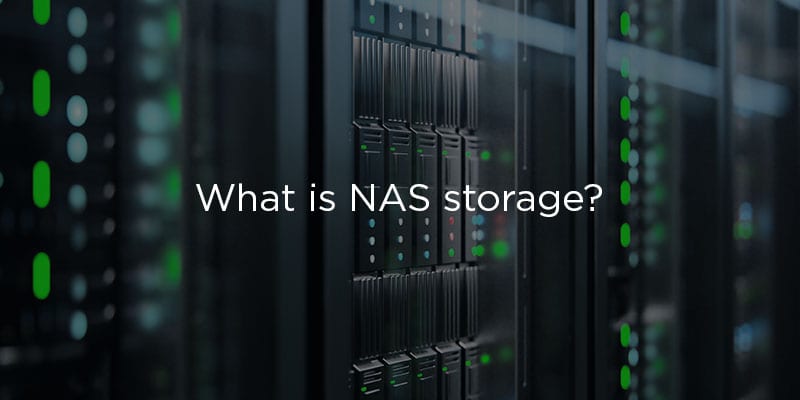Intro to Enterprise Data Storage: What is NAS Storage?


Technology has evolved so rapidly in the past few decades that the demand for high-quality data storage has exploded. The biggest hard drives thirty years ago would barely be able to store more than a couple of modern text documents. Floppy disks have been replaced by memory cards, USB drives, and CDs. Every single day, the world is creating over 2.5 quintillion bytes of data, with most of that data being created in the past few years. Enterprises are collecting all sorts of data: customer data, marketing data, sales data, productivity data, analytics, predictions, and much more.
When it comes to storing all of this data, it’s important for enterprises to be aware of the options available to them, and to be realistic about their needs. It can be easy to get lost in the world of data storage terminology, particularly when looking for the right solution for your business. The editors at Solutions Review are here to break down these terms and technologies, starting with one of the three most well-known types of data storage solutions: NAS. More complex than DAS but not as expansive as SAN, NAS storage is an approachable middleman regardless of business size, industry, or vertical.
What is NAS Storage?
NAS (Networked Attached Storage) refers to a type of server that makes storage available within a network. Its primary purpose is to provide centralized and shared access to unstructured data, including audio, video, websites, text files, and other important documents. Typically, NAS solutions are file-level data storage solutions connected to a specific computer network, which provides data access to a heterogeneous group of clients. This kind of solution is an absolute necessity for businesses and organizations that don’t want to store their data on a single computer or hard drive.
Instead of a single hard drive directly connected to your computer, NAS acts like an external hard drive for your entire network. It acts as a central server that manages your data, containing storage disks, drives, processors, and RAM. Each NAS storage unit resides on the LAN as an independent network node, and each has its own unique IP address. NAS typically has no keyboard or display, and is configured and managed on a separate computer with a browser-based utility application. If you’re looking for an easy way to share and simultaneously access data across a network, NAS is a good choice for your company.
NAS Storage Benefits
The biggest benefit of NAS is easy access to stored data by any networked device. Some vendors also offer remote access. NAS offers strategies for backup and capabilities to address redundancy needs. In addition to holding multiple mirrored hard drives, NAS can be formatted to support replicated disks, RAID configuration, and erasure coding to ensure data integrity. All of this functionality takes place inside a small physical space, compared to the sheer amount of physical storage required to store SAN solutions.
In terms of cost, NAS is much more approachable than something like SAN, and it provides greater value than DAS. At the same time, NAS only requires quick and simple setup. Typical NAS architectures are delivered with simplified scripts, or as appliances with pre-installed operating systems. With a much quicker initial setup than other storage solutions, NAS reduces the potential for frustration or the need to contact vendor customer service. Furthermore, NAS doesn’t require a dedicated IT professional to continue maintenance and management.
When it comes to scalability, NAS truly shines. It’s incredibly easy to add more storage capacity, you just need to add additional hard drives or storage disks to the unit itself. The hardware doesn’t need to be upgraded or replaced, and data is preserved throughout the process. The network doesn’t even need to be shut down. This will particularly benefit organizations on a budget, as buying one or two additional hard drives is much more cost-effective than having to buy an entirely new NAS solution.
What is NAS storage used for?
There are NAS solutions available at every business level, whether you’re a solo freelancer or a large enterprise. Nevertheless, NAS provides the most value for mid-sized businesses, and is also useful for companies that employ remote teams and workers in different time zones.
Enterprise NAS solutions are typically designed with more high-end data features to handle massive amounts of data storage and aid with storage management. They offer more space to scale and are capable of handling larger volumes of streaming media files, including virtual machine images. More storage requires larger capacity disks, more memory, and powerful network processing, but these capabilities are worth it if your business can afford it. If your NAS array has a server mode, it can be made to serve email, multimedia files, databases, and printing jobs. NAS can also be deployed as the foundation for a personal or private cloud.
Midmarket NAS solutions are appropriate for businesses that are handling hundreds of terabytes of data. Typically these solutions can’t be clustered, and may lead to file system siloes. Small-team NAS solutions are available, but the market has been shifting towards a more cloud-based model.
Other helpful resources
Aside from reading this guide, it can be helpful to have a more visual representation of what exactly NAS is and how it works, especially in comparison with DAS and SAN. In terms of other basic guides, it’s important to familiarize yourself with data storage terms and units of measurement. If you have specific data quantities that you need to store, knowing the capacity of different solutions is a necessity.
If you’re looking for a list of recommended enterprise data storage solutions, this list provides an overview of the 28 best companies to check out in 2020.
- Intro to Enterprise Data Storage: What is NAS Storage? - February 25, 2020
- Gartner Names Winners of 2020 Customers’ Choice for Primary Storage - January 27, 2020
- Data Storage Units of Measurement Chart from Smallest to Largest - January 24, 2020
























